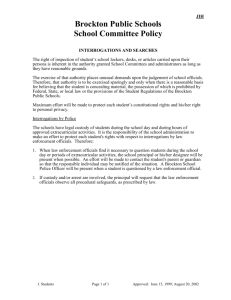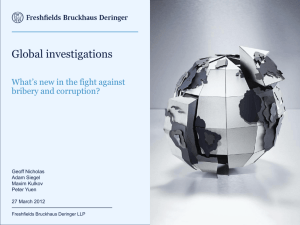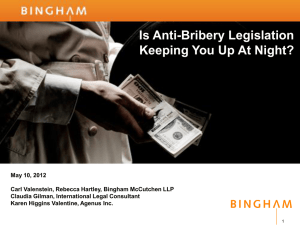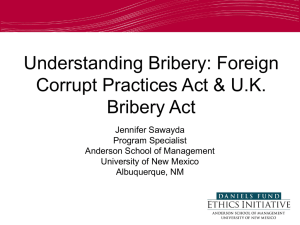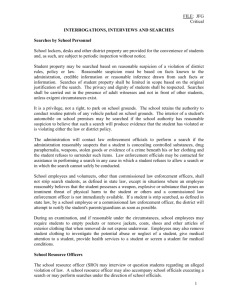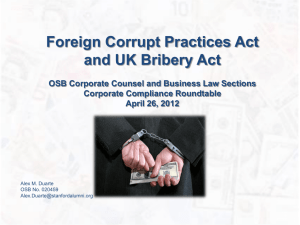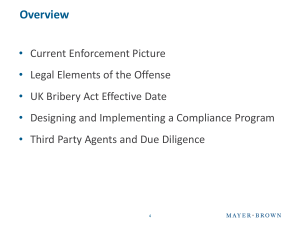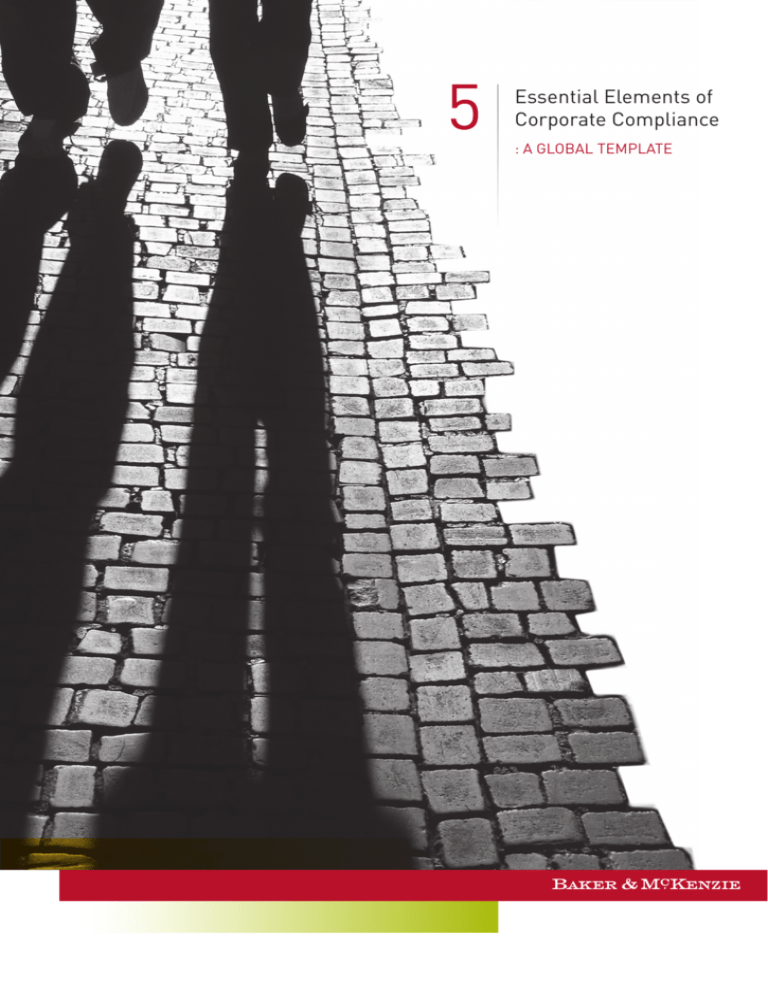
Essential Elements of
Corporate Compliance
: A GLOBAL TEMPLATE
Content
Introduction 4
Essential Element 1 - Leadership
6
Essential Element 2 - Risk assessment 8
Essential Element 3 - Standards and controls
10
Essential Element 4 - Training
12
Essential Element 5 - Oversight
14
Top 20 FCPA Settlements 16
Where the Bribes Are 16
Compliance Milestones 17
Map: Corruption Perceptions Index
18
Introduction
Today’s compliance environment
Maintaining a strong corporate compliance program designed to
help prevent corporate officers and employees from engaging in
illegal practices such as bribery, collusion, money laundering and
fraud sounds simple enough. In reality, it’s much more challenging.
Today’s multinational companies have thousands of employees,
multiple business partners and extensive operations throughout the
world, including in emerging markets where the rules of public and
commercial engagement often differ greatly from what they’re used
to at home.
In China, for example, foreign multinationals do most of their business
with state-owned or state-operated companies, which can get them
into trouble under the US Foreign Corrupt Practices Act’s prohibition
against making illegal payments to foreign officials. In Russia, a foreign
company may find it challenging to get its products into the country
without bribing customs officials. In Brazil, foreign companies may
have difficulty winning public bids without paying someone to shape the
request for proposal in their favor.
Despite the impact of globalization on the business landscape, enforcement
officials aren’t giving companies any breaks for improper behavior.
In fact, FCPA investigations have shot up dramatically in recent years,
fines have skyrocketed and multi-country government investigations
have become increasingly common. These days, a Brazilian subsidiary
of a US company that comes under investigation by Brazilian authorities
will likely also receive a subpoena from the US government.
With the stakes so high, what is a compliance-minded company to do?
Where should it look to evaluate the strength of its compliance program?
The answer to that question has become increasingly complicated. The
gold standard for what types of rules, protocols, communications and
oversight a company must have to meet the government’s compliance
program requirements used to be the US Sentencing Guidelines’ “Seven
Elements of an Effective Compliance Program,” originally published
in 1991. Since then, however, those guidelines have been revised
numerous times and other standards have been added to the equation.
4 | 5 Essential Elements of Corporate Compliance
In 2004, for example, the US government enacted additional
amendments to the federal sentencing guidelines for organizations.
The amendments placed an even greater emphasis on promoting a
culture of ethical corporate behavior by highlighting the responsibility
of boards of directors to oversee corporate compliance programs and
the importance of exercising due diligence to deter, prevent and detect
criminal conduct. In 2010, the Organization for Economic Co-operation
and Development released its “13 Good Practices on Internal Controls,
Ethics and Compliance.” A year later, the UK Ministry of Justice published
six principles for “adequate procedures” following the enactment of the
UK Bribery Act. Transparency International, a leading anticorruption
organization, has also established “Nine Business Principles for
Countering Bribery.”
Beyond those standards, US Justice Department prosecutors routinely
insert compliance program requirements into settlement agreements
they reach with companies under investigation for corruption —
further adding to the long checklist of what the government expects
companies to do to detect and prevent misconduct.
The good news is that although these guidelines vary in length, tone
and language, they have a lot in common. They all touch upon a set
of key issues that can be boiled down to five essential elements:
leadership, risk assessment, standards and controls, training and
communication, and oversight.
If a company’s corporate compliance program effectively covers
these five essential elements, it will likely fulfill the wide variety of
law enforcement expectations around the world and help prevent
costly prosecutions. In the event of a government investigation,
a company with a robust compliance program that encompasses
these five elements is much more likely to be granted compliance
credit, a reduction in penalties and other forms of leniency that could
ultimately minimize damages.
The key factors that US prosecutors consider when deciding whether
to file an enforcement action include a company’s level of cooperation
and its preexisting compliance program. To help companies meet
the government’s demands for maintaining successful compliance
programs, we’ve distilled the various standards to five essential
elements based on our extensive experience working on these cases
in jurisdictions around the world. For each element, we’ve included
specific actions that companies can take to ensure they are fulfilling
the requirements of each element.
Global compliance requirements
boiled down to five essential elements.
INTRODUCTION | 5
Leadership
What the guidelines
say about leadership:
USSG: Leaders understand
and oversee the compliance
program to verify its
effectiveness; specific
individuals have the authority
and responsibility to carry out
the program. The company
denies leadership positions to
people who have engaged in
misconduct.
OECD: Support from senior
management is strong,
explicit and visible. Program
is overseen by senior
corporate officers with
sufficient resources, authority
and access to the board.
UK’s 6 Principles: Top-level
commitment.
6 | 5 Essential Elements of Corporate Compliance
A successful compliance program must be built on a solid foundation
of ethics that are fully endorsed by senior management. Otherwise
it's just a hollow set of internal rules and regulations. But compliance
standards require even more than support from the top. Companies
must have high-ranking compliance officers with the authority
and resources to manage the program on a day-to-day basis. And
compliance officers must have the ear of those ultimately responsible
for corporate conduct, including the board of directors.
In fact, the US Sentencing Commission reinforced the importance
of giving compliance officers direct access to the board of directors
when it published amendments to the US Sentencing Guidelines in
2010. To receive a “culpability score reduction” during sentencing, a
company must now show that its compliance officers can promptly
report any matter involving criminal conduct directly to the board
or appropriate board committee. Compliance officers should also
report to the board on the implementation and effectiveness of the
company’s compliance program at least once a year.
As a best practice, however, we advise clients to take this component
of their programs a step further. We recommend that a company’s
chief compliance officer or legal department compliance manager
provide quarterly presentations to the board about ongoing internal
investigations, general developments in anticorruption laws and
enforcement, compliance challenges the company is facing and what
is being done to address those challenges. That way, it is clear that
the line of communication between the compliance team and the
board is open.
Recommendations
Make sure central compliance
is communicating with those
in the field. One of the biggest
impediments to effective
compliance leadership is poor
communication between a
company’s central compliance
department and country
managers working in the
field. This can be a major
oversight considering that
country managers are often
the employees in the trenches
overseeing sales people and
third-party agents who are
selling and distributing the
company’s products and
services. Neglecting to provide
appropriate compliance training
for country managers or keep
them in the corporate loop
increases the chances that
efforts to establish a strong
local compliance culture will
fail. Local managers are often
best situated to set the tone for
compliance and to detect and
address illegal or unethical
practices before they become
compliance issues that put the
company at risk.
Place compliance officers in
high-risk markets. Another
common oversight is failing to
have well-trained compliance
personnel in a company’s
foreign offices. Maintaining a
leadership structure that is too
centralized will stifle efforts
to foster a healthy compliance
culture across all geographies
and to minimize global risk.
Ethical edicts issued from
faraway headquarters are
often ineffective without buy-in
from local managers who have
the training and experience
to reinforce such rules. The
determination of which overseas
offices should have the strongest
compliance presence should be
made on a risk basis. Companies
can begin by building an active
presence of trained compliance
managers in markets with the
greatest compliance risk, then
expand this presence to other
jurisdictions.
Create a global compliance
committee. Another way to avoid
communication breakdown is to
establish a global compliance
committee comprised of trained
leaders from your central
compliance department, internal
audit, country managers and
local compliance officers
working in your foreign offices.
Here are some other
recommendations to
help your company fulfill
the leadership element of
effective compliance:
The committee should consider
holding monthly or bimonthly
conference calls to discuss
compliance issues and keep
members aware of potential
problems, as well as what is
being done to address them.
A commitment to this level of
global communication increases
your chances of establishing a
healthy compliance culture that
permeates the entire company.
Conduct periodic board training
and provide reports on hot
topics in compliance and risk
management. Corporate board
members face the possibility of
personal liability for failing to meet
their fiduciary responsibilities in
overseeing the business’ policies
and practices. With greater
awareness of compliance
issues from sources such as
whistleblowers and bloggers
comes a greater duty to act.
By providing regular, timely
compliance training for board
members and keeping them
updated on compliance and risk
management trends, general
counsel can help directors fulfill
their compliance obligations and
steer the company away from
potential misconduct.
LEADERSHIP | 7
Risk
assessment
What the guidelines
say about risk
assessment:
USSG: Companies must
conduct periodic assessments
of risk of criminal conduct
and take appropriate steps to
design, implement or modify
each element to reduce risk.
OECD: Risk assessment
should be the basis for
effective internal controls
and compliance programs.
UK’s 6 Principles: Broad
categories of risk must be
carefully examined, including
country, sectoral, transaction,
business opportunity and
partnerships. Program
priorities, resources and
controls should be determined
based on the results of the
risk assessment.
8 | 5 Essential Elements of Corporate Compliance
Although the original 1991 version of the US Sentencing Guidelines
did not specifically identify the completion of a formal risk assessment
as one of the seven elements of effective corporate compliance,
Sarbanes-Oxley directed the Commission to add it to the list.
As a result, government officials now routinely emphasize risk
assessments as the foundation of an effective program. What
changed? The answer may be globalization.
As multinationals have expanded their enterprises and grown more
dependent on global supply chains, knowing and understanding the
nature and extent of business risks has become a critical first step
for implementing successful compliance programs. Enforcement
authorities increasingly expect multinationals to have formal
processes for periodically assessing the compliance risks
everywhere they do business, particularly in higher-risk regions,
including emerging markets like China, Russia, India and Brazil.
During the risk assessment process, companies must evaluate
numerous compliance issues, including the degree to which the
company’s employees conduct business with government officials,
the company’s use of third-party agents and intermediaries, the
regulatory environment of the regions where the company operates,
and the effects of any recent business developments such as new
joint ventures, corporate affiliations, or expansion into markets that
could create additional risk.
Recommendations
Here are some recommendations
to help your company fulfill
the risk assessment element
of effective compliance:
Conduct annual risk assessments.
The purpose of a risk assessment
is to gauge where your company’s
greatest compliance risks are so
you can target your resources in
those areas and establish policies
and protocols to minimize those
risks. Yet it’s surprising how
many companies do not perform
this task. Companies will often
wait until something goes wrong
before self-assessing. To avoid
the inherent risks in the “wait and
see” approach, we recommend
that you conduct a formal
risk assessment every year.
Because enforcement trends
and anticorruption laws evolve
rapidly and multinationals tend to
go through numerous significant
changes within a given fiscal
year, we have found this to be an
optimal timeframe.
numerous enforcement actions
against companies for all kinds
of corporate misconduct. Paying
attention to the specific
compliance areas that the
government is targeting in these
enforcement actions will tell you
a lot about what your program
needs to focus on to stay out of
the government’s cross hairs. If,
for example, you notice that the
government has been clamping
down on gift giving and hospitality
in Asia and you conduct
considerable business in that
region, that should become
a focus area for your risk
assessment. Then, depending on
whether your hospitality policies
and procedures in Asia are in line
with what the government now
expects, you should make
necessary changes.
Build this annual risk assessment
into your compliance program.
Not only should you conduct
annual risk assessments, but you
should try to perform them at
the same time each year. To pass
muster with the government,
you need to demonstrate that
your risk assessment is a
regular, systemic part of your
compliance efforts rather
than an occasional, ad hoc
exercise cobbled together when
convenient. We also recommend
designating a specific group,
such as your internal audit
department or enterprise risk
management team, to conduct
the annual review. This will help
demonstrate to the government
that your risk assessment is a
formal corporate process.
Scrutinize new business partners
and third-party agents. One of
the areas that can get companies
into compliance trouble is
their lack of internal controls
over business partners and
third-party intermediaries such
as consultants, distributors,
contractors and sales agents.
In fact, the majority of FCPA
enforcement actions involve
some use of third parties.
Compliance standards require
companies to conduct due
diligence on new business
partners and third-party
intermediaries. But in the rush
to close deals and enter new
markets, that doesn’t always
happen as thoroughly as it
should. Conducting a formal
risk assessment each year
provides an opportunity to take
a closer look at newer business
relationships to make sure
partners and third parties do
not have improper connections
to government officials or
involvement in unethical or
illegal conduct. Any risk that you
uncover should be addressed
and remediated.
Update your policies and
procedures based on enforcement
trends. Throughout the course of
a year, government officials file
Memorialize your findings
in an annual report. When
conducted every year, routine
risk assessments should
only take three to four weeks,
depending on the size of your
company and your compliance
resources. Once the assessment
is complete, the compliance or
audit team should compile its
findings and recommendations
in a comprehensive report to be
presented to the chief compliance
officer and board of directors
for review and consideration
of appropriate program
enhancements.
RISK ASSESSMENT | 9
Standards
and controls
What the guidelines
say about standards
and controls:
USSG: Companies should
have standards and
procedures to prevent and
detect criminal conduct. They
should provide incentives and
discipline misconduct.
OECD: Company policy should
clearly and visibly state
that bribery is prohibited.
Compliance programs should
address key risk areas.
Companies should conduct
due diligence on business
partners and implement
effective internal controls for
accurate books and records.
Employees should be able to
report violations confidentially
without fear of retaliation.
UK’s 6 Principles: Policies
and procedures should
be clear, practical and
accessible. Companies should
have due diligence protocols
for screening third-party
intermediaries.
10 | 5 Essential Elements of Corporate Compliance
It would be challenging to find a global company today that doesn’t
have a code of business conduct — an easy-to-read summary of
corporate do’s and don’ts. But compliance standards require that
companies go much further. Besides a flagship code of conduct,
corporations should have detailed written policies covering issues
such as bribery, corruption and accounting practices, as well as
clear procedures and protocols for making sure those policies are
followed and enforced.
For example, a company’s code of conduct may state that bribery
is prohibited. However, best practices now require companies to
have additional standards and controls, including, for example,
detailed due diligence protocols for screening third-party business
partners for criminal backgrounds, financial stability and improper
associations with government agencies.
Ultimately, the purpose of establishing effective standards and
controls is to demonstrate that your compliance program is more
than just words on paper.
Recommendations
Here are some recommendations
to help your company fulfill the
standards and controls element
of effective compliance:
Establish stringent protocols
for screening business partners
and third parties. In most risk
assessments we perform
for clients, we find gaps in
the company’s third-party
due diligence program. Many
companies have not yet created
an effective platform for
screening business partners
and third-party intermediaries
for previous misconduct and
improper ties to the government.
Some companies still give
their business partners only a
cursory look — a considerable
oversight considering how often
government investigations involve
allegations of impropriety by a
company’s third-party agents.
To conduct proper due diligence,
companies must require third
parties and other business
partners to complete background
questionnaires detailing, among
other things, their financial
stability, foreign government ties
and any history of investigations.
Third parties should also
declare their commitment to
robust corporate compliance
in a signed certification form.
To increase accountability,
we also recommend using
business sponsor forms in
which employees who refer or
hire third-party agents provide
background information about the
agents, such as the experience
and attributes that qualify the
agents for the role they will play
as new company partners.
reconcile bank accounts with
outgoing and incoming payments
every month and inquire into
any suspicious payments
and missing funds that could
indicate misappropriation or
off-the-books transactions.
Companies should pay particular
attention to transactions with
consultants and business
development agents, customs
payments, charitable giving
arrangements, and gifts and
hospitality involving government
officials.
Conduct background checks on
important business partners in
high-risk markets. Performing
background checks on third
parties can be an expensive
undertaking. But it may be
advisable when screening major
business partners and third
parties in higher-risk markets to
make sure they’ve represented
themselves accurately in their
paperwork. Accordingly, consider
hiring trained, local investigators
to get an even clearer picture of
whether your potential partner
could become a compliance
liability.
Include strict compliance
covenants in your third-party
contracts. Today’s best practice
compliance standards also
strongly encourage companies
to require third parties and
other business partners to sign
contracts with provisions that give
the company the right to monitor
their conduct. At a minimum,
these compliance covenants
should cover three core concerns:
adherence to the FCPA and other
international anticorruption
laws, audit rights, and contract
termination rights. More
specifically, these provisions
should require the business
partner to agree not to violate the
FCPA and other anticorruption
laws, to give the company the
right to review the partner’s
books and records, and to enable
the company to terminate the
contract if it later determines
the partner is engaged in
misconduct, unethical behavior
or illegal activity.
Establish internal controls to
ensure accounting records are
accurate. The FCPA requires
companies to book transactions
correctly by securing receipts
and accurately recording the date
and amount of the payment. To
be compliant, companies should
Provide clear guidelines for gift
giving and hospitality. Giving
clients and business associates
gifts, treating them to dinner
or taking them to sporting
events are common business
development practices. But
anything too extravagant could
quickly cross the line into
bribery. Differences in culture
and economic prosperity can
make it difficult for companies
to establish one-size-fits-all
gift-giving and hospitality
guidelines for the countries
where they conduct business.
While paying $150 a head for
a business dinner in France
may not constitute bribery, for
example, in poorer countries like
Nigeria or Cambodia it could.
That’s why it’s so important
to tailor hospitality policies to
individual countries. Companies
can do this in any number of
ways, including creating a
thresholds table of allowable
hospitality amounts that is based
on local laws and regulations
in each country where they
operate, plus advice from
experienced local counsel.
STANDARDS AND CONTROLS | 11
Training
What the guidelines
say about training:
USSG: Companies must
communicate the standards
and procedures of its
compliance program and
conduct effective training.
OECD: Training should be
periodic, consistent, and
documented.
UK’s 6 Principles: Effective
implementation of
compliance program policies
and procedures through
adequate training.
12 | 5 Essential Elements of Corporate Compliance
One of the most important elements of a strong compliance
program is properly training company officers, employees and
third parties on relevant laws, regulations, corporate policies, and
prohibited conduct. In recent years, the rise of technology platforms
such as webinars, video conferencing and online self-testing has
made training easier and more affordable.
But simply conducting some compliance training for employees
isn’t enough. Enforcement officials want to be sure management's
message got through. Thus, when determining whether a company’s
training program meets its expectations for effectiveness, the
government often scrutinizes who a company trains, how the
training was conducted and how often training occurs.
Recommendations
Provide live compliance
training for country managers.
If resources permit, officers and
managers in your foreign offices
should receive live, in-person
compliance training every year,
particularly those working in
your highest risk markets. In the
compliance world, anticorruption
laws, enforcement trends and
government priorities change
quickly. Thus, waiting more
than a year to conduct periodic
compliance training can impede
awareness. If lack of resources
is an issue, conducting live
videoconferences or webinars
with question-and-answer
sessions is a good alternative.
Train the right people. When
providing compliance training,
it’s important to prioritize
which audience to educate first,
particularly when you have
limited resources. Besides
country managers, it’s important
to focus your initial training
efforts on high-risk markets
and directors, officers and
sales employees who have
direct contact with government
officials or deal with state-owned
entities. Then expand the training
around the globe and across your
employee spectrum.
Conduct live, annual training in
high-risk markets. Enforcement
officials have made it clear that
live, in-person training is the
preferred method in high-risk
markets and that this training
should be relatively frequent.
Therefore, merely conducting a
simple five-question online FCPA
test in a higher-risk country such
as Russia, or performing training
in China once every five years
will probably not be sufficient
from a regulator’s perspective.
Also, one of the many benefits
of conducting live, in-person
training is that you often receive
immediate feedback when talking
to employees in person that you
would not typically get from an
online course or webinar. During
live training, employees are
more likely to casually mention a
potentially risky practice, giving
you the opportunity to address an
impropriety before it becomes a
larger problem.
Develop your training to address
a broad range of global issues.
Some companies make the
mistake of having a generic
script for all compliance training
that misses the practical
challenges employees routinely
face. Training programs typically
Here are some recommendations
to help your company fulfill the
training element of effective
compliance:
cover the FCPA, UK Bribery Act,
OECD guidelines and enforcement
trends in other countries.
Additionally, you need to focus on
the specific compliance risks in
the country where the employees
are working. In China, for
example, training should address
the many corruption risks of
dealing with state-owned entities.
In Brazil, training should include
guidance on how to handle
government officials who expect
facilitation fees to move business
processes along more quickly.
Update your training regularly.
Enforcement trends and
anticorruption laws change
quickly, and government officials
are increasingly collaborating
across borders to conduct largescale investigations. That’s why
it is important to monitor what’s
happening around the world and
incorporate those developments
into your training. Compliance
is a global issue that requires
corporate vigilance and constant
attention. By providing timely,
effective employee training,
companies can demonstrate their
commitment to cultivating and
supporting a strong compliance
culture.
TRAINING | 13
Oversight
(Monitoring, Auditing, and Response)
What the guidelines say
about oversight:
USSG: Companies should
monitor and audit their
compliance programs
and maintain reporting
mechanisms. They should
respond quickly to allegations
and modify their programs as
needed.
OECD: Individuals at all levels
of the company should be
responsible for monitoring.
Companies should discipline
employees for violations
of the policy. Companies
should regularly review their
compliance programs and
make necessary revisions.
UK’s 6 Principles:
Companies must monitor
and review their compliance
programs.
14 | 5 Essential Elements of Corporate Compliance
After all the ethical messages have been put in place and
communicated to the appropriate audiences, the question
remains whether the workforce is actually complying. Two of
the seven compliance elements in the US Sentencing Guidelines
call for corporations to monitor, audit, and respond quickly to
allegations of misconduct. These three activities — monitoring,
auditing and responding — are key components enforcement
officials look for when determining whether companies
maintain adequate oversight of their compliance programs.
Many companies, however, fall short on this element, often
because of confusion about the differences between monitoring
and auditing. Monitoring is a commitment to reviewing and detecting
compliance problems in real time, then acting quickly to remediate
them. The primary goal is to identify and address gaps in your
program on a regular basis. An audit is a more limited review that
targets a specific business component, region or market sector
during a particular timeframe to uncover or evaluate certain risks.
Some companies assume that because they conduct audits or
have a dedicated auditing team, they are effectively monitoring.
This is usually not the case. A robust compliance program
should include separate monitoring and auditing functions.
While unique in protocol, however, these two program components
are often viewed as compliance “cousins” because they often work in
tandem. If, for example, you notice a trend of suspicious payments in
recent monitoring reports from Indonesia, you may decide it’s time to
conduct an audit of those operations to target and further investigate
the issue.
Recommendations
Here are some recommendations
to help your company fulfill the
oversight element of effective
compliance:
Establish a regular monitoring
system to spot problems
and address them. Effective
monitoring means applying
a consistent set of protocols,
checks and controls tailored to
your company’s risks to detect
and remediate compliance
problems on an on-going basis.
For example, your compliance
team should be checking in
regularly with local finance
departments in your foreign
offices to ask whether they’ve
noticed recent accounting
irregularities. Also, as part of
their corporate compliance
accountability, regional business
directors should be required
to keep tabs on potentially
improper activity in the countries
they manage. And your global
compliance committee or
enterprise risk group should talk
as often as feasible (perhaps
every month) to discuss and
address issues as they arise.
Ongoing efforts like these will
show the government that you
are serious about compliance.
is thorough and authentic.
Those procedures should
include document preservation
protocols, data privacy policies,
and communication systems
designed to manage information
and get it to the appropriate
people quickly. Best practice
compliance guidelines also
encourage companies to
establish disciplinary policies
that clearly state how they
regulate and discipline employees
engaged in misconduct.
Require country managers to
complete regular compliance
reports. One of the nine factors
that US prosecutors consider
when deciding whether to file an
enforcement action is whether
a company is applying its
compliance program in good faith.
The program may look good on
paper but the government wants
to know, is it really working?
One of the most effective ways
of answering that question is
being able to show prosecutors
regular, periodic monitoring and
auditing reports prepared by
senior executives and managers
across your operations.
Pay attention to what employees
say during training. Training is
a form of monitoring because
it can alert you to potential
problems based on the types
of questions employees ask
and their reception to certain
concepts. For example, during
training employees sometimes
ask specific questions about their
interactions with government
officials or gift-giving practices
that can raise red flags, which
should be addressed quickly.
Establish protocols for internal
investigations and disciplinary
action. Responding swiftly
and effectively to compliance
issues will sometimes require
your company to conduct an
internal investigation. Before
an internal investigation,
however, each company should
have procedures in place to
make sure every investigation
Remediate problems quickly. A
key concept behind the oversight
element of effective corporate
compliance is the idea that if
companies are policing themselves
for compliance-related issues,
the government won’t have to do
it for them. That is why remediation
is such an important component
of oversight. If it’s clear, for
instance, that your sales people
in Thailand are doing something
potentially improper partly
because they never received
adequate compliance training,
remediate the deficiency by
scheduling that training
immediately. In the end, it’s not
enough to just gather information
and identify compliance problems.
To fulfill this essential element of
compliance, you have to fix them.
OVERSIGHT | 15
Top 20 FCPA Settlements*
Company
Industry
1
2
3
4
5
6
7
8
9
Siemens
KBR/Halliburton
BAE
ENI S.p.A.
Technip
JGC Corporation
Daimler
Alcatel-Lucent
Deutsch / Magyar Telekom
Electronics
Engineering/Energy
Aerospace
Energy
Engineering/Energy
Engineering/Energy
Automotive
Telecommunications
Telecommunications
$800 million
$579 million
$400 million
$365 million
$338 million
$219 million
$185 million
$137 million
$95 million
2008
2009
2010
2010
2010
2011
2010
2010
2011
10
11
12
13
14
15
16
17
18
19
Panalpina
Johnson & Johnson
ABB
Pride International
Marubeni Corporation
Baker Hughes
Willbros
Chevron
Titan
Bridgestone
Freight forwarding/Transportation
Pharmaceutical/Consumer goods
Technology
Energy
Trade
Engineering/Energy
Engineering/Energy
Energy
IT/Communications
Auto parts manufacturing
$82 million
$70 million
$58 million
$56 million
$54 million
$44 million
$32 million
$30 million
$29 million
$28 million
2010
2011
2010
2010
2012
2007
2008
2007
2005
2011
Consumer Electronics
$26 million
2012
20 Tyco International
Fine (USD)
*Fines listed are as of February 1, 2012
Where the Bribes Are
Passed in 1977, the FCPA has led to more than 200 cases covering illegal activity in 80
countries. Companies in certain industries are more prone to prosecution than others.
Here is a list of the total FCPA fines by industry since 1977.
Energy
Consulting
Defense & Aerospace
Manufacturing
Telecommunications
Infrastructure
Health & Pharmaceuticals
Agriculture
Source: James Mintz Group
16 | 5 Essential Elements of Corporate Compliance
$2.03 billion
$846.76 million
$443.29 million
$225.80 million
$218.14 million
$144.34 million
$84.62 million
$50.83 million
year of settlement
Milestones
1909
New York Central & Hudson River Railroad v. U.S., 212 U.S. 481
1991
Amendments to U.S. Sentencing Guidelines
Significance: In this case, NY Central Railroad and one of its managers were convicted of bribery
for giving lower shipping rates to certain sugar companies in violation of the Elkins Act. NY
Central Railroad argued that Congress had no authority to hold the company responsible for a
crime committed by one of its employees. In affirming the conviction, the US Supreme Court
ruled for the first time that a company can be held criminally liable for the acts of its employees
who commit crimes to benefit the company.
Significance: For the first time, the US government provided a framework for how companies
should deter and prevent crimes such as corporate fraud, bribery and collusion. Now often
referred to as the “seven elements of effective compliance,” the underlying theory was that if
companies received sentencing breaks for having bona fide compliance programs, they would be
motivated to police themselves internally. Largely as a result of these guidelines, today’s public
companies and the majority of private ones maintain corporate compliance programs.
DOJ Principles of Federal Prosecution of Business Organizations
1999
2002
Significance: In this memo written by then-Deputy Attorney General Eric Holder Jr., the
DOJ established nine factors federal prosecutors must consider when deciding whether to
charge a corporation with criminal misconduct. Those factors include a company’s “timely and
voluntary disclosure of wrongdoing” and its “willingness to cooperate in the investigations of its
agents.” The principles, which have been amended many times in recent years, have had a major
impact on the fate of corporations being investigated for corruption. A subsequent memo written
by then-Deputy Attorney General Paul McNulty in 2006 required prosecutors to give companies
credit for having a pre-existing compliance program when deciding whether to charge them.
This provision of the McNulty Memo gave companies greater incentive to become more proactive
in establishing corporate compliance programs before they came under investigation.
Sarbanes-Oxley Act
Significance: Enacted following accounting scandals at corporations such as Enron, WorldCom
and Tyco, this act, often referred to as “SOX,” established new financial requirements for US
public companies, such as requiring that all financial statements include an internal controls
report certifying their accuracy. It also created new accountability for chief executives, corporate
boards and auditors, who can be held personally liable for noncompliance. A CEO or CFO who
submits an inaccurate certification, for example, is subject to a fine up to $1 million and up
to 10 years in prison. SOX also encourages the disclosure of corporate fraud by protecting
whistleblower employees who report illegal activities.
FCPA Enforcement Surge
2005
Significance: Since 2005, the DOJ and SEC have brought more than 200 FCPA enforcement
actions against corporations and their officers and employees — a huge number considering
that these agencies had filed less than 60 actions in the previous 27 years since the FCPA
was enacted. In the past decade, the US government has made FCPA enforcement a much
greater priority by hiring more prosecutors, training specialized anti-corruption units, targeting
corporate officers along with companies, encouraging corporations to self-disclose violations
and investigating more small and mid-sized companies. That surge in enforcement has led to
a corresponding surge in corporate compliance. For example, during the uptick in enforcement,
the DOJ and SEC have used calculated messages in settlement papers and public appearances
to provide guidance on how companies can enhance their anti-corruption compliance programs
to mitigate penalties and avoid prosecution. This, in turn, has motivated companies to strengthen
their compliance policies and procedures, hire experienced compliance officers, broaden FCPA
training efforts, and develop more robust internal controls.
UK Bribery Act
2010
Significance: Since the FCPA was enacted in 1977, it has been the most far-reaching,
aggressively enforced anti-corruption statute in the world. By passing the Bribery Act, the
UK joined the US in providing its regulators with broad powers to prosecute foreign bribery —
putting multinational companies at even greater risk of criminal and civil liability. In some ways
the Bribery Act is even stricter than the FCPA because it makes it illegal for companies and its
agents to bribe anyone, not just foreign officials. It also makes no concessions for facilitation
payments — small fees paid to government employees to expedite or secure performance
of routine governmental actions. The only defense to the Bribery Act’s corporate offense for
“failure to prevent bribery” by an associated person is the company’s ability to prove it had
“adequate procedures” in place to prevent bribery at the time of the alleged impropriety.
| 17
2012
Corruption
CORRUPTION
Perceptions Index PERCEPTIONS
INDEX 2011
THE PERCEIVED LEVELS OF PUBLIC-SECTOR CORRUPTION
IN 176 COUNTRIES/TERRITORIES AROUND THE WORLD
THE PERCEIVED LEVELS OF
PUBLIC-SECTOR CORRUPTION
IN 176 COUNTRIES/TERRITORIES
AROUND
THE WORLD
SCORE
Highly
Corrupt
Very
Clean
0-9
10-19 20-29 30-39 40-49 50-59 60-69 70-79 80-89 90-100
RANK COUNTRY/TERRITORY SCORE
1
1
1
4
5
6
7
7
9
9
11
12
13
14
15
16
17
17
19
20
20
22
22
Denmark
Finland
New Zealand
Sweden
Singapore
Switzerland
Australia
Norway
Canada
Netherlands
Iceland
Luxembourg
Germany
Hong Kong
Barbados
Belgium
Japan
United Kingdom
United States
Chile
Uruguay
Bahamas
France
90
90
90
88
87
86
85
85
84
84
82
80
79
77
76
75
74
74
73
72
72
71
71
22
25
25
27
27
29
30
30
32
33
33
33
36
37
37
39
39
41
41
43
43
45
46
Saint Lucia
Austria
Ireland
Qatar
United Arab
Emirates
Cyprus
Botswana
Spain
Estonia
Bhutan
Portugal
Puerto Rico
Saint Vincent and
the Grenadines
Slovenia
Taiwan
Cape Verde
Israel
Dominica
Poland
Malta
Mauritius
Korea (South)
Brunei
18 | 5 Essential Elements of Corporate Compliance
71
69
69
68
68
66
65
65
64
63
63
63
62
61
61
60
60
58
58
57
57
56
55
RANK COUNTRY/TERRITORY SCORE
46
48
48
50
51
51
53
54
54
54
54
58
58
58
61
62
62
64
64
66
66
66
69
Hungary
Costa Rica
Lithuania
Rwanda
Georgia
Seychelles
Bahrain
Czech Republic
Latvia
Malaysia
Turkey
Cuba
Jordan
Namibia
Oman
Croatia
Slovakia
Ghana
Lesotho
Kuwait
Romania
Saudi Arabia
Brazil
55
54
54
53
52
52
51
49
49
49
49
48
48
48
47
46
46
45
45
44
44
44
43
69
69
72
72
72
75
75
75
75
79
80
80
80
83
83
83
83
83
88
88
88
88
FYR Macedonia
South Africa
Bosnia and
Herzegovina
Italy
Sao Tome and
Principe
Bulgaria
Liberia
Montenegro
Tunisia
Sri Lanka
China
Serbia
Trinidad and
Tobago
Burkina Faso
El Salvador
Jamaica
Panama
Peru
Malawi
Morocco
Suriname
Swaziland
43
43
42
42
42
41
41
41
41
40
39
39
39
38
38
38
38
38
37
37
37
37
RANK CO
88
88
94
94
94
94
94
94
94
94
102
102
102
105
105
105
105
105
105
105
105
113
113
Th
Za
Be
Co
Dj
Gr
Ind
Mo
Mo
Se
Ar
Ga
Ta
Al
Ar
Bo
Ga
Ko
Ma
Me
Ph
Al
Et
43
43
42
42
42
41
41
41
41
40
39
39
39
38
38
38
38
38
37
37
37
37
RANK COUNTRY/TERRITORY SCORE
88
88
94
94
94
94
94
94
94
94
102
102
102
105
105
105
105
105
105
105
105
113
113
Thailand
Zambia
Benin
Colombia
Djibouti
Greece
India
Moldova
Mongolia
Senegal
Argentina
Gabon
Tanzania
Algeria
Armenia
Bolivia
Gambia
Kosovo
Mali
Mexico
Philippines
Albania
Ethiopia
37
37
36
36
36
36
36
36
36
36
35
35
35
34
34
34
34
34
34
34
34
33
33
113
113
113
118
118
118
118
118
123
123
123
123
123
128
128
130
130
130
133
133
133
133
133
Guatemala
Niger
Timor-Leste
Dominican
Republic
Ecuador
Egypt
Indonesia
Madagascar
Belarus
Mauritania
Mozambique
Sierra Leone
Vietnam
Lebanon
Togo
Côte d´Ivoire
Nicaragua
Uganda
Comoros
Guyana
Honduras
Iran
Kazakhstan
33
33
33
32
32
32
32
32
31
31
31
31
31
30
30
29
29
29
28
28
28
28
28
RANK COUNTRY/TERRITORY SCORE
133
139
139
139
139
139
144
144
144
144
144
144
150
150
150
150
154
154
156
157
157
Russia
Azerbaijan
Kenya
Nepal
Nigeria
Pakistan
Bangladesh
Cameroon
Central African
Republic
Congo Republic
Syria
Ukraine
Eritrea
Guinea-Bissau
Papua New
Guinea
Paraguay
Guinea
Kyrgyzstan
Yemen
Angola
Cambodia
28
27
27
27
27
27
26
26
26
26
26
26
25
25
25
25
24
24
23
22
22
157 Tajikistan
160 Democratic
Republic of the
Congo
160 Laos
160 Libya
163 Equatorial Guinea
163 Zimbabwe
165 Burundi
165 Chad
165 Haiti
165 Venezuela
169 Iraq
170 Turkmenistan
170 Uzbekistan
172 Myanmar
173 Sudan
174 Afghanistan
174 Korea (North)
174 Somalia
22
21
21
21
20
20
19
19
19
19
18
17
17
15
13
8
8
8
Source:
© 2012 Transparency International. All rights reserved.
2012 CORRUPTION PERCEPTIONS INDEX | 19
www.bakermckenzie.com
Baker & McKenzie has been global since inception.
Being global is part of our DNA.
Our difference is the way we think, work and behave – we combine
an instinctively global perspective with a genuinely multicultural
approach, enabled by collaborative relationships and yielding practical,
innovative advice. Serving our clients with more than 4,000 lawyers in over
40 countries, we have a deep understanding of the culture of business
the world over and are able to bring the talent and experience needed
to navigate complexity across practices and borders with ease.
Contacts
If you have any questions about this document or would like more information about our Global
Corporate Compliance Practice, please contact Sue Boggs at sue.boggs@bakermckenzie.com /
+1 214 965 7281.
© 2012 Baker & McKenzie. All rights reserved. Baker & McKenzie International is a Swiss Verein with member law firms around the world.
In accordance with the common terminology used in professional service organizations, reference to a “partner” means a person who is a partner,
or equivalent, in such a law firm. Similarly, reference to an “office” means an office of any such law firm.
This may qualify as “Attorney Advertising” requiring notice in some jurisdictions. Prior results do not guarantee a similar outcome.

